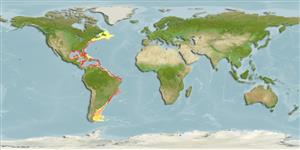Fissidentalium carduus (Dall, 1889)
Yellow tuskshell| Native range | All suitable habitat | Point map | Year 2050 |

|
| This map was computer-generated and has not yet been reviewed. |
| Fissidentalium carduus AquaMaps Data sources: GBIF OBIS |
Upload your photos
Google image |
No photo available for this species.No drawings available for Dentaliidae.
Google image |
No photo available for this species.
Classification / Names Common names | Synonyms | CoL | ITIS | WoRMS
Scaphopoda | Dentaliida | Dentaliidae
Environment: milieu / climate zone / depth range / distribution range Ecology
Benthic; depth range 60 - 600 m (Ref. 1821). Tropical
Distribution Countries | FAO areas | Ecosystems | Occurrences | Introductions
Western Atlantic: USA to Uruguay, Caribbean.
Length at first maturity / Size / Weight / Age
Maturity: Lm ? range ? - ? cm Max length : 8.9 cm SHL male/unsexed; (Ref. 3441)
Short description Morphology
Shell is long, slightly curved, regularly tapering, yellowish grey. Six primary ribs, secondary ribs present, attaining rapidly similar size of primary ones, transverse riblets present producing a rasp-like surface. Apex with a deep, narrow slit at the convex side. Oral section polygonal, circular or slightly dorsoventrally compressed (Ref. 3441).
Empty shells collected from depths of 40 to 1980 m (Ref. 3441). Minimum depth from Ref. 111279.
Life cycle and mating behavior Maturity | Reproduction | Spawning | Eggs | Fecundity | Larvae
Members of the class Scaphopoda are gonochoric. Fertilization occurs in the mantle cavity. Life cycle: Eggs hatch into free-swimming lecithotrophic trochophore larvae, succeeded by shelled veligers.
Main reference
References | Coordinator | Collaborators
Steiner, G. and A.R. Kabat. 2004. (Ref. 1821)
IUCN Red List Status (Ref. 130435)
CITES status (Ref. 108899)
Not Evaluated
CMS (Ref. 116361)
Not Evaluated
Threat to humans
Human uses
| FishSource |
Tools
More information
Internet sources
BHL | BOLD Systems | CISTI | DiscoverLife | FAO(Publication : search) | Fishipedia | GenBank (genome, nucleotide) | GloBI | Gomexsi | Google Books | Google Scholar | Google | PubMed | Tree of Life | Wikipedia (Go, Search) | Zoological Record
Estimates based on models
Preferred temperature
(Ref. 115969): 1.8 - 18.4, mean 5.2 (based on 231 cells).
Price category
(Ref. 80766):
Unknown.


